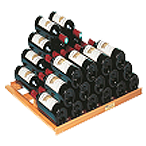More About Champagne Types & Styles
Champagne has many different types/styles based on; the grapes in the blend, time spent aging in the caves, the “dosage” sweetener added, vintages, and most importantly, the producer’s style which they try to make a consistent “house” style” year after year. All of the types come in both lighter and heaver body styles. Champagne major styles include; Non-vintage, Vintage, Blanc de Blanc, Blanc de Noirs & Rose.
Most Champagnes are nonvintage (NV) and are a blend of three grapes—Pinot Noir, Pinot Meunier (red) (now called just Meunier) and Chardonnay. But seven permitted varieties can be grown in Champagne. The other four are Pinot Gris, Pinot Blanc, Petit Meslier and Arbane.
Champagnes are also a blend of several vintages and several wines, often from many villages throughout the region and are the least expensive Champagnes.
Blanc de Blancs
Blanc de Blancs Champagnes are some of the very best Champagnes made mostly from Chardonnay. They are especially long-lived.
Blanc de Noirs
Blanc de noirs are the rarest, golden-colored Champagne, usually made with only Pinot Noir and sometimes Pinot Meunier.
Rosé Champagne
Pink-colored rosé Champagne, usually made from a blend of Pinot Noir and Chardonnay.
These three types of Champagne come both in vintage and nonvintage (NV) (multi-vintage) forms.
Vintage Champagnes are made from only one “good” vintage year, and usually from superior vineyards and are best known for aging beautifully for a long time and represent about only 10% of production.
Prestige Cuvées
Prestige Cuvées are usually vintage Champagnes whose grapes come from the very best vineyards rated grand cru or premier cru by the CIVC, Champagne’s regulatory board. Their bubbles are finer—very tiny and delicate. Their aromas and flavors are more intense, more complex and more elegant and their finishes are longer. They are also aged longer in cellars before they’re released (from five to eight years) than other NV Champagnes are aged about three years and standard vintage Champagnes are aged four to five years). Try to hold on to any prestige cuvées for about 15 years from the vintage date before popping the cork. They should age for up to 25 years or more in good vintages.
Champagne Aging
Champagnes are aged for a minimum of 15 months before to their removal from the bottle dégorgement. Even NV Champagnes improve with two or three years of aging after release especially those from certain producers. In most cases, NV Champagnes are meant to be enjoyed near their disgorgement, or release date, for optimal freshness, but many can age nicely for 5 years after they receive their cork. However, some top producers like to release their Tête du Cuvée “Grand Cuvée” as a multi-vintage every year and these can easily age 20+ years under the right storage conditions. Many producers print the disgorgement information on their back label, so you can tell how long a bottle of NV Champagne has been sitting on the shelf. Prestige cuvees from top producers are built to age as well, as they typically spend a very long time on their yeast which acts as s a body-building seasoning and as a kind of preservative. For this same reason, vintage Champagne often outlives its non-vintage counterparts. About 10-30+ years for top houses’ Vintage or Tête du Cuvées releases, or ‘Special Club’ releases from small grower-producers.
“RD”, or “recently disgorged” champagnes are held back release with a new cork years later.
Sparkling Wines Sweetness/Sugar Levels gram/liter (g/l) teaspoons per 5 oz serving spoons/serving:
- Brut Nature (Brut Zero) 0-3 grams/liter <1/6 table spoons/serving
- Extra Brut 0-6 grams/liter <1/4 table spoons/serving
- Brut 0-12 grams/liter <1/2 table spoons/serving
- Extra Dry 12-17 grams/liter 1/2-3/4 table spoons/serving
- Dry 17-32 grams/liter 3/4-1 table spoons/serving
- Demi-Sec 32-50 grams/liter 1-2 table spoons/serving
- Doux 50+ grams/liter over 2 table spoons/serving







